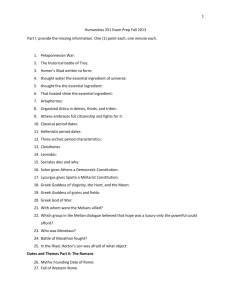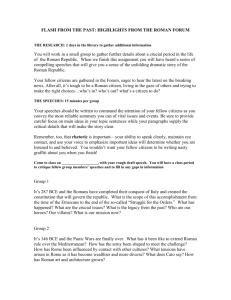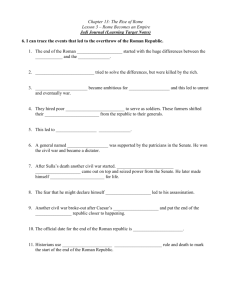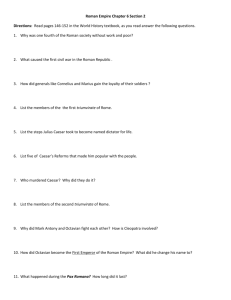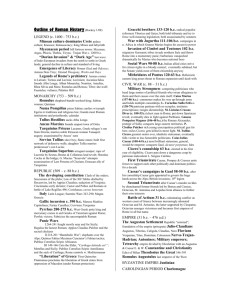Humanities 251 Final Exam Prep Cyrus the Great rising Fall of
advertisement
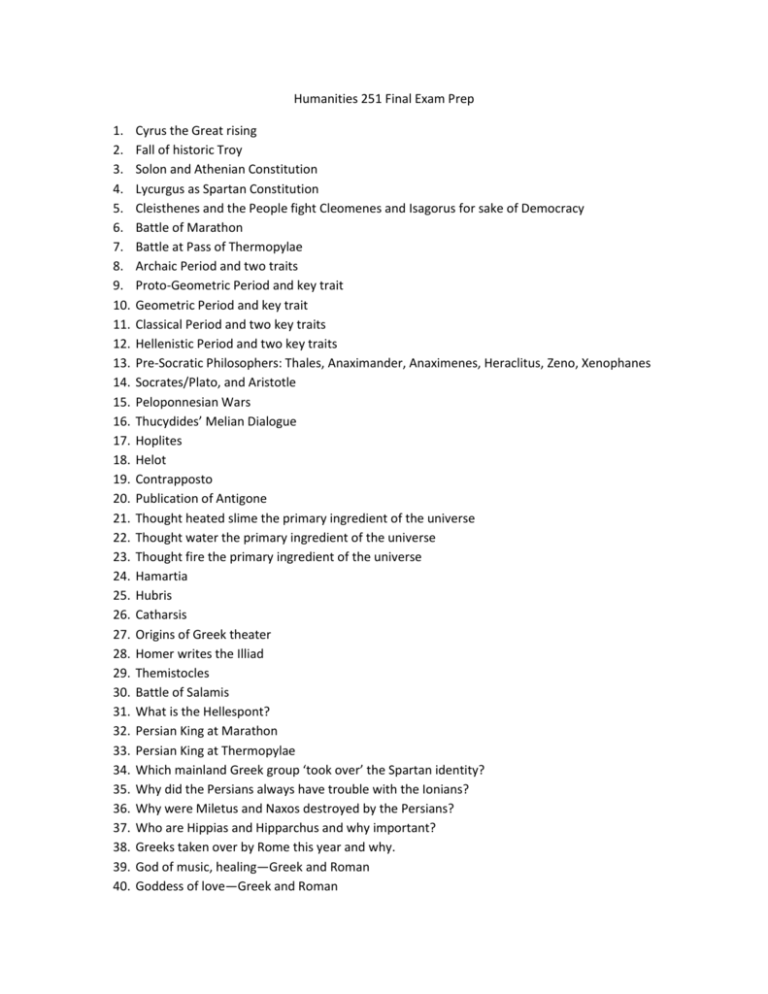
Humanities 251 Final Exam Prep 1. 2. 3. 4. 5. 6. 7. 8. 9. 10. 11. 12. 13. 14. 15. 16. 17. 18. 19. 20. 21. 22. 23. 24. 25. 26. 27. 28. 29. 30. 31. 32. 33. 34. 35. 36. 37. 38. 39. 40. Cyrus the Great rising Fall of historic Troy Solon and Athenian Constitution Lycurgus as Spartan Constitution Cleisthenes and the People fight Cleomenes and Isagorus for sake of Democracy Battle of Marathon Battle at Pass of Thermopylae Archaic Period and two traits Proto-Geometric Period and key trait Geometric Period and key trait Classical Period and two key traits Hellenistic Period and two key traits Pre-Socratic Philosophers: Thales, Anaximander, Anaximenes, Heraclitus, Zeno, Xenophanes Socrates/Plato, and Aristotle Peloponnesian Wars Thucydides’ Melian Dialogue Hoplites Helot Contrapposto Publication of Antigone Thought heated slime the primary ingredient of the universe Thought water the primary ingredient of the universe Thought fire the primary ingredient of the universe Hamartia Hubris Catharsis Origins of Greek theater Homer writes the Illiad Themistocles Battle of Salamis What is the Hellespont? Persian King at Marathon Persian King at Thermopylae Which mainland Greek group ‘took over’ the Spartan identity? Why did the Persians always have trouble with the Ionians? Why were Miletus and Naxos destroyed by the Persians? Who are Hippias and Hipparchus and why important? Greeks taken over by Rome this year and why. God of music, healing—Greek and Roman Goddess of love—Greek and Roman 41. 42. 43. 44. 45. 46. 47. 48. 49. 50. 51. 52. 53. 54. 55. Goddess of intellect—Greek and Roman God of war—Greek and Roman Goddess of hunting, the moon, and virginity—Greek and Roman Angry sister wife of Zeus—Greek and Roman With whom were the Melians allied against whom? Leonidas What happened at the Oracle of Delphi? What is a seed-corn allegory and example of one? What did the Persian King of Kings demand of subject nations yearly? Assyrian King dates of Assyrian power, and power city Median King, dates of Median power, and power city Who paraded a statuesque peasant girl into Athens, claiming she was the goddess Athena? Menelaus was king of what group, living and fighting in what century? Name two sons of King Priam. On what peninsula do the Spartans and Argives and Messenians live? Dates and Themes Part II: The Romans and Northern Europeans. 1. 2. 3. 4. 5. 6. 7. 8. 9. 10. 11. 12. 13. 14. 15. 16. 17. 18. 19. 20. 21. 22. 23. 24. Mythic Founding Date of Rome: Fall of Western Rome Fall of Eastern Rome (Constantinople) Promulgation of the 12 Tables Punic Wars: 264-201 Destruction of Carthage, Africa and Greece become Roman Provinces: 146 BCE First Triumvirate: 60 BCE: Pompey, Caesar, Crassus Caesar’s Conquest of Gaul: Breca Unferth Fall of Eastern Rome Gregory the Great sends Christian missionaries into Northern Europe this century Battle of Pharsalus: Caesar defeats Pompey the Great in Greece, meets Cleopatra. Caesar Sole Dictator of Rome: (assassinated March 15th-the Ides of March) Second Triumvirate: 43 BCE Antony, Lepidus, Octavian Battle of Actium, won by Octavian against Antony and Cleopatra Octavian Augustus Caesar rules, the Pax Romana: Birth of historic Jesus, and death; 6 BCE/30 CE Burial of Pompeii: Virgil: (70-19 BCE, Aeneid 30 BCE) Propertius Elegies: (50-15 BCE, Elegies 29 BCE) Germanic leader who most opposed Caesar What Roman Emperor first used smear campaign tactics? What had to happen in the Roman Senate before Octavian could make war on Mark Antony? 25. 26. 27. 28. 29. 30. 31. 32. 33. 34. 35. 36. 37. 38. 39. 40. 41. 42. 43. 44. 45. 46. 47. 48. 49. 50. 51. 52. 53. 54. From his household, Aeneas took with him his son, his father, and what else? Tacitus Germania: Germania published 98 BCE Reign of Diocletian: 284-305 CE/ Edicts of Diocletian Reign of Constantine 307-337 (sole emperor after 324 CE) Suppression of Paganism, Christianity made state Religion: Vandals, Goths, Visigoths, Germanic Hordes invade 409-455 CE Last Legionaire leaves the British isles Fall of Western Rome; 476 CE. Clovis, King of the Franks, adopts Christianity 594 CE. Parable of the Sparrow Comitatus Scop wirgild Frei-dom Fate Often Saves an Undoomed Man if his Courage is good. Christmas Day, 800 CE, Charlemagne, King of the Franks, Crowned Holy Roman Emperor: end of the comitati. Who stayed loyal to the aging Beowulf during the fight with the dragon? What happened to the troop accompanying the old Beowulf to fight the dragon? Beowulf written sometime during this time span, referring to events as far back as? Why do Germans boast? The Germans were invited across the Rhine by which Gallic group and why? Who are the Helvetti? Who is Mithra and why important? Three character traits of the Romans Three character traits of the Germanic tribes In our days of the week, which are named for what north gods and goddesses? Whom did Aeneas have to kill to fulfill his fate of starting the Roman Empire and why? What did the shade of Dido do when she met Aeneas in the underworld during the nekua? When did the northmen—the Danes, Geats, Swedes, begin invading Britain? The Germans? Final Exam Plan: I. II. Quick identifications dates/events/terms Images and Maps III. Essays (2, take home, 3 page types responses each) Essays: *What makes a good leader? Examining models from Persia, Greece, and either Rome or Northern Germany, consider the traits of those leaders who have helped their people live long and prosper. What do they have in common? How do they differ, and why? Ultimately, who do you think possesses the leadership traits that you personally admire, and why? How would your choice fare as a leader today? Whatever texts you use, include the Aeneid as one. *It is easy to see that the role of women in culture has changed from the time of the Ancient Greeks to that of the early medieval Northern Europeans. But beyond that, how have women been portrayed in our readings from Greek, Roman, and Germanic culture? What has been their functional role or roles within their respective communities? Do you find any commonalities, or any important distinctions? If so, why do you suppose these exist, and as commonalities or distinctions, how do they play today in anything like a portrait of the role of contemporary American women? To what end? Whatever texts you use, include “Antigone” as one of them, and the character of Dido from the Aeneid as another. *This term we have examined documents and events key to four distinct cultural groups—the Persians, the Greeks, the Romans, and the Northern Europeans. Given what you have discovered, consider the human condition. Is it improving or progressing? If so, in what ways? If not, why not— and to what end? Use specific details from our readings and notation of key events to support perhaps three general assertions about the human condition you make, and based on your supported assertions, what do you predict for our future? *It is often said that human beings are generally conflictful. Is this true? If so, prove it, given at least four of our texts read this term, and speculate about what this means for any relationship we ought to maintain to our past, as well as how we ought to go about making our future. If not conflictful, then what are we, and likewise speculate. Remember, the devil is in the details. Whatever texts you use, include the “Melian Dialogue” among them. *The Illiad, Medea, Caesar’s Gallic Wars, and Tacitus’ Germania, and Beowulf tell the story of men at war, or of cultures dominated by warring men. But there are also several women in the books. Based on those whom we have met, what are the varied roles of women within the community of these ancient Greeks, Romans, and Germans? How did those roles change over time and space, and how do they differ from one another, and from the roles of women in contemporary American society? What do you make of what has remained the same, and of what has so changed? What are your predictions for the future role of women in American society, given its Greco-Roman-Germanic past? This for 6 page take home essay for Northern European Section, to replace 50% Exam grade for the Northern European period. This is optional. If you choose to write it, turn it in at the time of the final and it will serve for the Northern European exam grade. If not, the Northern European Exam grade will be rolled in with the comprehensive final. RK *The Germanic peoples lived by a strict set of laws or cultural codes. In the literature, we see the heroes judged in relation to what has come to be referred to as the Heroic Code for behavior. Identify at least three aspects of this Heroic Code as you find evidence for them in Gallic Wars, Germania, and Beowulf. Further, compare and contrast these character traits to generic traits for both the Roman understanding of the heroic code, and our own understanding of Heroic behavior for men and women today, living in the 21st century, in Minot, as you see them. Speculate about the significance of what has changed, and what has remained the same. What is more, as a culture that is always in the process of rewriting codes, where are we headed in our future understanding of the heroic code? Be thoughtful, specific, and organized in your response.
